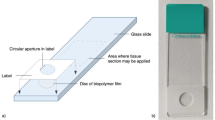Summary
The aim of this study was to investigate the staining characteristics of Victoria Blue B in alcohol solutions. Cytological specimens (liver and spleen tissue imprints, blood smears) were stained with methanol solutions of commercially available Victoria Blue B-Cl and with pure Victoria Blue B-BF4. The dye concentration, staining time, and protone concentration of the dye solution were varied. The dye solutions were characterized using spectrophotometry and thin-layer chromatography. Cytophotometry and image analysis were used to quantitate the staining pattern of cell nuclei. Feulgen-stained slides were used as controls. Victoria Blue B-BF4 gave excellent nuclear staining exhibiting a quantitative dye-substrate relationship, whereas commercial dyes resulted in lower staining intensity and less distinct nuclear texture. Dye concentration and staining time were, over wide ranges, not of critical importance for the quality of the staining. Under certain staining conditions, only cell nuclei were stained, with the background remaining completely unstained. We presume that, in alcohol solutions, Victoria Blue dye binds as a neutral dye molecule in conjunction with its anion. Victoria Blue B-BF4 staining provides a simple and reproducible staining technique for cytology which is suitable for use in automated cell-pattern recognition.
Similar content being viewed by others
References
Coats E (1969) Aggregation of dyes in aqueous solutions. J Soc Dyers Colour 85:355–368
Drawert H (1968) Vitalfärbung und Vitalfluorochromierung pflanzlicher Zellen und Gewebe. Protoplasmatologie II D 3 Springer, Wien New York
Gilliland JW, Dean WW, Stastny M, Lubvano GJ (1979) Stabilized Romanowsky blood stain. Stain Technol 54:141–149
Graumann W (1953) Zur Standardisierung des Schiffschen Reagens. Z Wiss Mikrosk 61:225–226
Goldstein DJ (1961) Mechanism of differential staining of nucleic acids. Nature 186:407–408
Harms H (1965) Handbuch der Farbstoffe für die Mikroskopie. Staufen-Verlag, Kamp-Lintfort
Horobin RW (1983) Histochemistry. Theoretical and applied. G. Fischer, Stuttgart
Horobin RW, Bennion PJ (1973) Interrelation of the size and substantivity of dyes: the role of van der Waals attractions and hydrophobic bonding in biological staining. Histochemie 33:191–204
Ivic M (1959) Neue selektive Färbungsmethode der A- und B-Zellen der Langerhansschen Inseln. Anat Anz 107:347–350
Lillie RD (1977) Conn's biological stains. Williams and Wilkins, Baltimore
Lillie RD, Reynolds C, Pizzolato P (1979) Phosphomolybdic and phosphotungstic acid — Victoria Blue R stains two histo-chemically distinct collagens: dense dark blue and loose areolar pale green. J Histochem Cytochem 27:1092–1094
Lucke S, Ziegler B, Diaz-Alonso JM, Hahn HJ (1985) Eignung spezifischer Färbemethoden für die Bestimmung des B-Zell-volumens im Rattenpankreas mit normalem und reduziertem Insulingehalt. Acta Histochem 77:107–116
Lustgarten S (1886) Victoriablau, ein neues Tinctionsmittel für elastische Fasern und für Kerne. Med Jahrb 1:285–289
Marshall PN, Horobin RW (1973a) The mechanism of action of “mordant” dyes — a study using preformed metal complexes. Histochemie 35:361–371
Marshall PN, Horobin RW (1973b) Measurements of the affinities of basic and “mordant” dyes for various tissue substrates. Histochemie 36:303–312
Nettleton GS, Martin AW (1979) Separation of Fuchsin analogs using thin layer chromatography. Stain Technol 54:213–216
Perrin DD, Dempsey B (1974) Buffers for pH and metal ion control. Chapman and Hall, London, pp 76–81
Romeis B (1968) Mikroskopische Technik. R Oldenbourg, München Wien
Tsekos I (1973) Mikrospektralphotometrische Untersuchungen zum Speichermechanismus der kationischen Farbstoffe Viktoriablau B und 4R durch die lebende und tote Pflanzenzelle. Histochemie 36:201–217
Wittekind D (1985) Standardization of Dyes and Stains for Automated Cell Pattern Recognition. Anal Quant Cytol Histol 7:6–30
Wittekind D, Schulte E (1987) Die Bedeutung der Standardisierung der Zell- und Gewebspräparation für bildanalytische Operationen. Labormedizin (in press)
Wittekind D, Hilgarth M, Kretschmer V, Seiffert W, Zipfel E (1982) The new and reproducible Papanicolaou stain. Anal Quant Cytol Histol 4:286–294
Wohlrab F, Hahn von Dorsche H, Krautschick I, Schmidt S (1985) On the specificity of insulin staining by Victoria Blue 4R. Histochem J 17:515–518
Zanker V (1981) Grundlagen der Farbstoff-Substrat-Beziehungen in der Histochemie. Acta Histochem (Suppl) 21:151–168
Author information
Authors and Affiliations
Additional information
Dedicated to Professor Dr. T.H. Schiebler on the occasion of his 65th birthday
This study was supported by a grant from the Bundesministerium für Forschung und Technologie, Bonn-Bad Godesberg, Federal Republic of Germany, (no. 01 Z08501/6)
Rights and permissions
About this article
Cite this article
Schulte, E., Wittekind, D. & Kretschmer, V. Victoria blue B — a nuclear stain for cytology. Histochemistry 88, 427–433 (1988). https://doi.org/10.1007/BF00570305
Accepted:
Issue Date:
DOI: https://doi.org/10.1007/BF00570305




